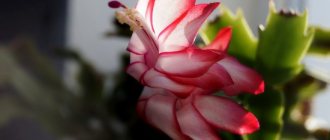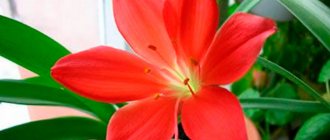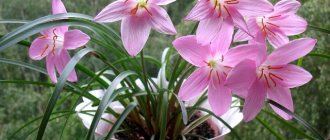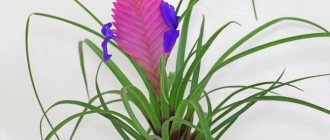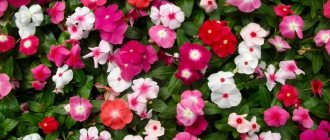Reo is an indoor plant, up to 50 centimeters high, with a small creeping trunk, on which is attached a rosette with oval, elongated leaves, smooth and green on top, and velvety and purple below, the length of the leaves is from 25 to 30 centimeters. Often this indoor plant is classified as one of the types of Tradescantia, although this is a controversial issue. Reo is actually a close relative of zebrina and tradescantia, all of which belong to the Commelinaceae family. But some botanists believe, and this would be more correct, that such a flower forms its own separate genus, Reo.
Description of the flower
Reo is a herbaceous plant native to the tropical forests of South America. It is distinguished by its dense leaves, which reach up to 30 cm in length. They come in purple, green or striped. In mid-July, the plant produces white flowers.
Reo, or as gardeners like to call it, Tradescantia variegated, is an attractive houseplant from the Commelinaceae family. The flower is found mainly on the edges of the tropics; it likes to grow near rivers and lakes, which indicates its endurance. Reo is as unpretentious as a cactus, but as beautiful as an orchid. Therefore, it is ideal for beginners.
The stem of the flower is thick and dense, standing straight. It grows up to 30-40 cm in height, its leaves grow in different directions, and the shape of the plant is always different.
Bloom
Most often, flowering occurs in summer. But with good care, the plant blooms several times a year. When the “caps” fade, new ones form in their place. For beautiful lush flowering, this representative of the flora needs a large amount of light. Inflorescences are formed at the base of the trunk. They are endowed with an unusual shape. They are several convex, intersecting bracts.
These leaves resemble small mollusk shells. They are also sometimes called “miniature boats.” Thanks to such leaves, the plant is popularly called the “Rook of Moses.” Miniature snow-white flowers form between the amazing leaves.
Home care
Reo is an unpretentious and beautiful indoor plant, but you need to remember a few rules in order to successfully care for it. The plant loves light; a south window is the best place for it. But in the summer heat, Reo still needs to be shaded a little, otherwise the leaves will suffer from the sun's rays.
Reo flower is poisonous! When working with this flower, you must be careful, as the juice of this tradescantia is poisonous. It is irritating to the skin and can cause contact dermatitis.
Lighting
The flower loves diffused sunlight, just like in its natural environment, in the tropics. Therefore, it is better to place it on a window facing east or west. The natural light he will receive will be quite enough. On the south side you need to create a little shade, the north side is undesirable: the leaves lose color and the stems become very elongated.
Temperature
Reo variegated prefers moderate temperatures, 20-24 degrees Celsius is ideal. However, if the temperature is higher, the flowers can easily tolerate it. Temperatures below 15 degrees Celsius are undesirable for the plant.
Humidity
Of course, for the variegated rheo, the ideal option would be a humidity of more than 70%, again as in a natural tropical environment. During the heating season, regularly humidify the air; you can place a flower pot in a special tray with wet pebbles, where you should regularly add water. If you do not maintain the required level of humidity for Reo variegated, the leaves may dry out.
Watering
The plant loves abundant watering, so it needs to be provided regularly. It is better to use softened water at room temperature; in winter, reo likes water a little warmer.
The flower likes constantly moist soil, so it’s not scary if someone mistakenly waters it again. Handsome Reo grows remarkably well when the ground is always wet during the warm season. But in winter you need to be more careful with watering, you need to reduce it a little, but there should not be drying out. It is advisable to water with settled water; rain water is even better for this. In winter, the flower should be watered with warm water. And yet, the flower really doesn’t like it when water gets into the places on the stem where the leaves are attached (the internode), you need to try to prevent this from happening.
The flower develops well if it is sprayed regularly. A summer shower is a great way to keep your flower toned and clean.
Top dressing
Flowers need to be fed a couple of times a month with the usual universal fertilizer, which is used for decorative deciduous plants. In winter, reo motley does not need feeding.
How to pinch
Reo has a dense, upright and gnarled stem, from which multi-colored leaves and a well-developed rhizome stretch upward in different directions. To form bushiness, the upper shoots and trunk are pinched, and then the rheo thanks the owners with a lush cap that covers the pot and extends beyond it. To make the plant look more impressive, different varieties are mixed when planted in one pot. As a result, you get not only a luxurious bush, but also a natural composition that is captivating with its varied colors.
Trimming
The lower leaves of the reo can be trimmed periodically, but it is still better to re-grow the plant every few years. Faded inflorescences should be cut or pinched off.
Transfer
Young variegated rheo needs annual replanting into larger, wider, but shallow pots, because the root system of the flower grows in breadth.
The soil
The plant prefers a light and nutritious substrate with an acidity of 5.5 pH to 6.5 pH. It is worth making a special drainage layer at the bottom of the pot.
Transfer
As a rule, the flower grows as a bush and young shoots constantly appear at the base of the bush, so it simply needs replanting every year. For this, it is better to use wide pots, given the fact that the flower grows wider. The substrate can be purchased ready-made or prepared independently from the following components:
- 1 part clay-turf soil.
- 1 part leaf soil.
- 1 part peat.
- 1 part humus.
- 1 part sand.
Considering that the plant loves abundant watering, it is necessary to provide it with powerful drainage, without which it is better not to plant the flower, as it will fester or the roots will be affected by root mites.
But no matter how simple the care may seem, problems in the development of the flower can still be observed. This can happen when the one who has this flower growing simply forgets about it, which is unacceptable. If such problems are detected, you should look for the cause and try to neutralize it.
Where is it better to place according to esotericism?
The most favorable place to place a flower is considered to be the center of the house. This zone is associated with protecting the energy field, attracting good luck and spirituality.
There are several zones in the house that are responsible for love, children, career, health and well-being. For a specific zone to take effect, it must be activated. This is achieved through the correct arrangement of flowers, their biofield.
On the south side of the apartment, the plant may wither from direct sunlight; on the west side, the conditions are most suitable. Placing the flower in the health zone helps to cope with diseases faster. The southwest side is considered the zone of love and marriage.
Those who believe in the magical properties of Tradescantia claim that it is an amulet, protects against haters, and blocks the negative effects of black sorcerers.
Reproduction
The flower is easily propagated using cuttings or side shoots; the roots form well not only in the soil, but also in an ordinary container with water. Reo can be propagated either by seed or by apical or lateral cuttings. With the vegetative method of propagation, in the spring the selected cuttings are carefully (with a disinfected and sharp knife) separated from the main plant and planted in separate containers with a sand-peat mixture, moistened and placed in a room with an air temperature of about twenty degrees. Cuttings also root very easily in water with the addition of a growth stimulator. To prevent rotting, the lower leaves are removed from the cuttings . After the roots appear, the shoots are transplanted into pots.
Adult flowers can always be divided:
- into 2-3 parts, simultaneously rejuvenating the plant and reducing the size of the growing container;
- separate individual side shoots, which quickly take root and begin to grow in separate pots.
Usually, division, rather than cuttings, is chosen when growing in ampels, because the volume of containers is limited and with constant growth the rheo becomes too heavy.
Sowing seeds should be done in mid-spring in boxes with peat and sand. Plantings need to be moistened and covered with polyethylene film. Spraying and airing of crops should be carried out daily. The seeds germinate easily and quickly, and the seedlings grow quickly. But at the same time, you need to remember that only plants with green foliage can be propagated in this way, since decorative characteristics are not preserved in this case.
Isn’t it a muzhegon Tradescantia?
The purple tradescantia, or netcreasia, is considered a homewrecker. Superstitious people believe that she can easily quarrel two loving hearts. Some are convinced of the opposite. Setcreasia, like a sponge, absorbs negativity, and then from an overabundance it splashes everything out. Others believe that the plant dies in a family where husband and wife often conflict with each other.
ON A NOTE. Tradescantia Zebrina is considered a “husband plant.” She cannot be kept at home, so as not to be left without a man. It is better to admire the flower in the office or at exhibitions.
In any case, everyone must decide for themselves what to believe in and what not.
Varieties - photo
The following varieties of reo are most suitable for cultivation indoors:
Reo discolor Vittata is a short representative of the genus with bright, yellow stripes on the leaves;
Reo discolor Compacta is a violet-green specimen with excellent bushiness;
Reo discolor Stripe in Pink is a very beautiful flower with an original color: the purple surface of the leaves is decorated with pink stripes on the upper side and the same, but with a purple tint, on the back side of the leaf.
Application
A wild tropical plant is used in folk medicine recipes. But in Europe, reo is valued for its high decorative value. The multi-colored varieties are especially beautiful. To enhance the decorative effect, flowers of several types are planted in one pot, resulting in bright floral arrangements.
In medicine
The houseplant is used by folk healers in its homeland in America. The juice is used to treat bleeding gums. The leaves are infused or a decoction is made from them. It is believed that the decoction alleviates the condition of respiratory tract diseases. The heated leaves are used to make a compress for joints for rheumatism. A decoction of flowers is used as an ambulance for stool disorders.
In cosmetology
Ancient peoples used the irritating effects of Tradescantia juice to give a glow to the skin. At the current level of development of cosmetology, this method is hardly applicable. Moreover, the active substances in the juice can cause an allergic skin reaction.
Diseases and pests
Reo is rarely affected by diseases and pests. But if not cared for properly, a scale insect may appear on it, which needs to be washed off with a soap solution, and then the plant is completely treated with an insecticide. Infection with rot or powdery mildew may also occur. In this case, you need to remove all damaged parts of the plant, and spray the remaining parts with a fungicide solution. If these measures do not give the desired result, you need to destroy the infected plant.
First, the tips of the leaves change color to brown and then dry out.
The main reason for this problem is too dry air in the room. As a rule, dry air is formed in winter, after turning on the heating system. In this case, the plant needs to be sprayed more often, and in addition, place a bucket of water near it.
The tips of the leaves begin to turn brown, and then curl and begin to dry out.
This may indicate that the plant is not sufficiently watered and watered with sufficiently cold water. For watering, you should use only warm water and well-settled water, then everything will be fine.
The flower begins to stretch out, there are fewer leaves on it
The reason for this may be lack of lighting or lack of microelements.
Variegated species begin to lose their contrasting color, as a result of which the longitudinal stripes become difficult to distinguish
This effect can occur as a result of excessive lighting. In this case, the reo can be moved to a more shaded place.
The stems become cottony (soft) and their color changes to brown
This occurs from excess moisture in winter. The best way to preserve the flower in this case is replanting. To do this, you need to cut off a healthy shoot and try to root it in the ground or in water. If there is a threat of death of the flower, then this procedure can be carried out at any time of the year.
Names and brief descriptions of indoor flowers with purple leaves
The unusual color of the leaves can be of various shades: from light lilac to deep purple. It can be uniform, can be located on both sides of the leaf at once, and there are options where this color is presented on one side - only on the top or bottom, while the other part remains the usual green. Purple on both sides are the well-known wood sorrel (night butterfly) with small triangle leaves, irezine (which needs a large amount of light to maintain the brightness of the color). The types of Herbst irezine and Purple Lady irezine are monochromatic.
Stromanta as a flower garden decoration
The upper side of the leaves is purple
Among the whole variety of indoor flowers, painted in this unusual, unusual shade only on top, the most popular is hemigraphis alternating. There are more than 100 species of this plant in nature. At home, ampel and semi-ampel forms are grown. It can be perennial or annual. The plant is whimsical, but looks very impressive.
Oxalis oxalis
With proper care, the ovoid, serrated leaves turn purple on top (its saturation changes depending on the lighting), while remaining light green on the reverse side.
Hemigraphis alternating
The underside of the leaves is purple
There are other plants with leaves that are purple only on the bottom. The most common among them:
- reo is the most popular plant, whose lower part of the leaves is purple in color. It attracts flower growers with its unusual appearance and lack of pickiness in care. In addition, reo also blooms beautifully;
- ginura. There are several varieties, but the most popular and unpretentious is the variety Ginura braided. This is an ampelous species with velvety leaves. The leaves are shaped like nettles, but have an unusual color in the lower part;
Reo during the flowering period
- purpusa. This is a close relative of Tradescantia, and therefore caring for it is quite problematic. It is a long vine. The leaves are olive-reddish in color and slightly hairy on top, and smooth and deep purple below.
Note! All plants in this group may change color slightly depending on the lighting.
Signs
Reo's leaves, which have a double color, suggest that there is some kind of mystery hidden in them.
- Indeed, if you have a reo flower in your home, it can have a double effect on those living: it increases the creative activity of those who possess it, and reduces the level of tension and aggression that can periodically arise in relationships.
- The plant has a beneficial effect on everyone who is engaged in any useful work: its energy encourages creativity and forces you to finish what you start.
- The reo flower normalizes the atmosphere in the house, neutralizing negative energies and increasing the level of positive vibrations; signs indicate that the presence of this indoor plant in the house increases the vital activity of household members, helps to organize thoughts, give them a positive direction, and develops creative thought and imagination.
The plant gives its owner eloquence and the ability to think logically. The reo flower, as evidenced by signs and superstitions, is able to protect against witchcraft and curses, and keeps the residents of the house from bad deeds, makes them think about the consequences of rash actions, and also clears thoughts of negativity.
What is the meaning of reo in feng shui?
According to ancient Chinese practice, the reo flower is able to restore a person’s emotional balance, improve health, and relieve nervous tension. It should be healthy, without signs of wilting. This is very important, otherwise the energy of death will hover throughout the house.
Tradescantia Reo balances the zone of love and health and goes perfectly with camellia, impatience, hibiscus and gardenia flowers. Taken together, their effectiveness increases several times.
